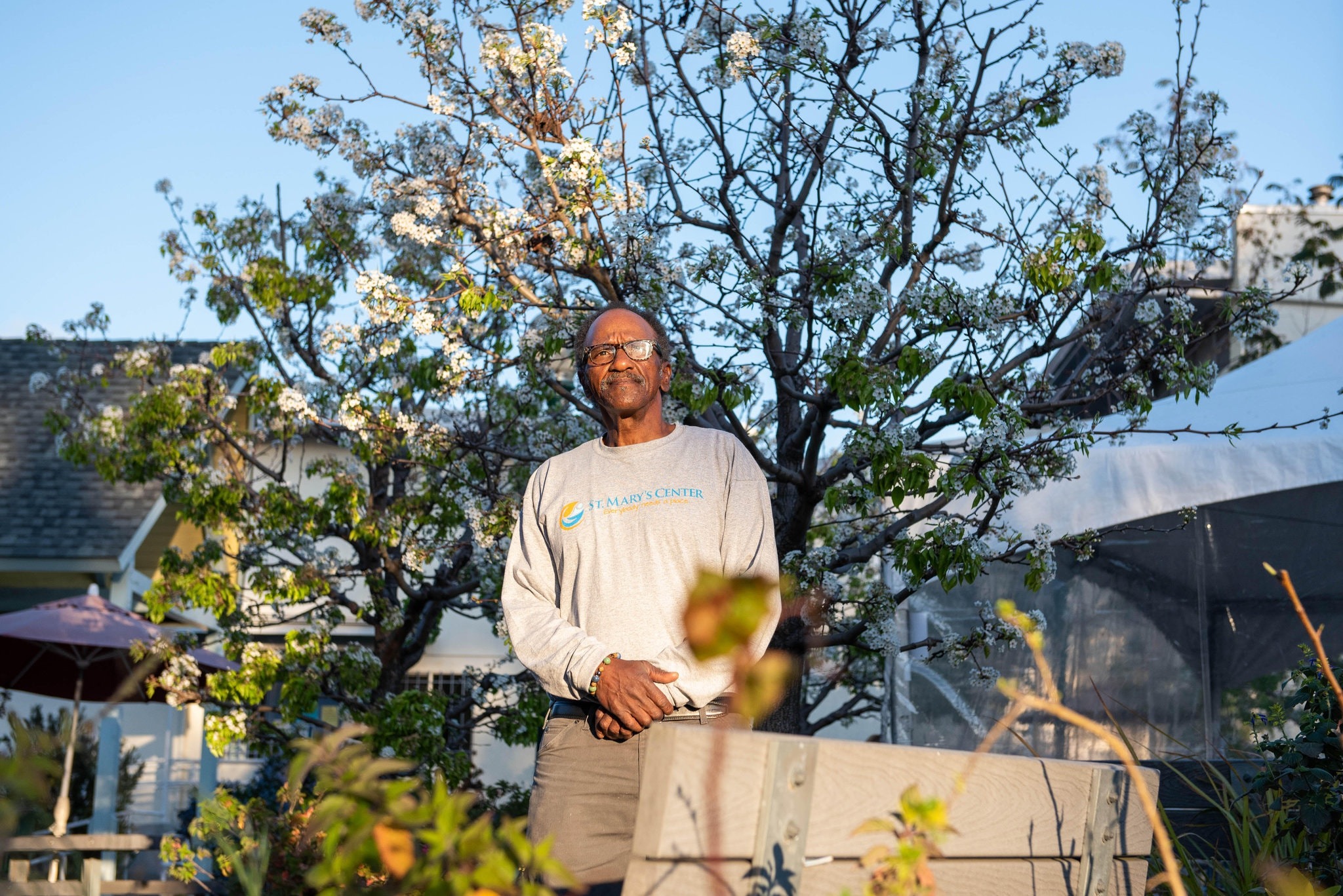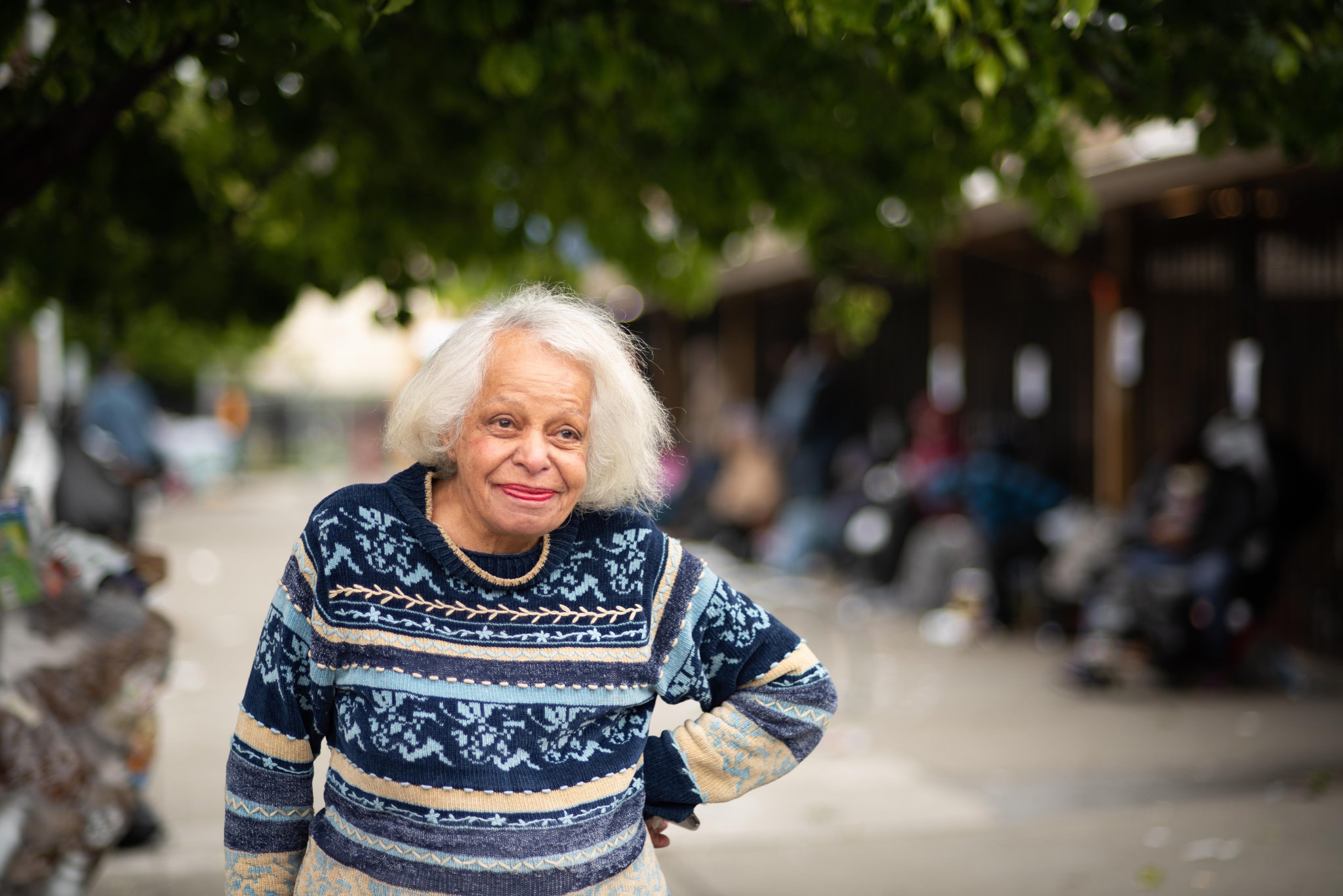Inside the Bay Area’s Geriatric Homeless Shelter

Anthony Deloney in the courtyard garden at St. Mary’s Center in Oakland on March 31. Mr. Deloney was one of only 11 homeless seniors still residing at St. Mary’s, the only senior homeless shelter in the Bay Area, before it closed last week. Stephanie Penn
April 23, 2020
OAKLAND — Anthony Deloney is homeless and 63 years old, a frightful combination in this pandemic. Yet this is how Mr. Deloney described his fate on a recent Thursday afternoon: “Every day the sun rises, there’s something for me to look forward to.” His hopefulness, it turned out, rested on a single lucky break that graced an otherwise hard-luck life.
Mr. Deloney had found refuge in the only homeless shelter in the Bay Area dedicated to serving seniors.
There are some 28,000 homeless residents in this region. Thousands are senior citizens. Out of that population, just 11 homeless seniors — Mr. Deloney among them — found themselves quarantined inside St. Mary’s Center in downtown Oakland. They were watched and worried over by a vigilant, exhausted staff of mostly volunteers who worked around the clock in masks and gloves serving meals, delivering medicine, changing sheets, cleaning toilets, sanitizing surfaces and doing their utmost to make sure no one from the infected world beyond the center’s steel gates set foot inside.
“The good Lord takes care of the blind and crippled as well as the seniors,” Mr. Deloney said as he gave an impromptu tour of the center’s garden of blossoming trees and flowers.
“We don’t think about the virus in here,” he said.
But, in fact, the virus was about all Sharon Cornu could think about. As the executive director of St. Mary’s, Ms. Cornu was all too aware of how the novel coronavirus is ravaging places where the elderly live in close quarters. Only weeks ago, men in hazmat suits were carrying bodies out of a nursing home in nearby Hayward, where scores of residents were infected.
She was no less fearful of what will happen if the virus begins to hopscotch through the Bay Area’s vast shadow world of homeless encampments. How long, she wondered, could shelters like St. Mary’s stay virus free? The question hit especially hard when officials disclosed that 96 residents in a homeless shelter in San Francisco had tested positive for Covid-19. In New York, at least 23 shelter residents have died from the outbreak.
“None of our procedures anticipated this scale of a global pandemic,” Ms. Cornu said.
The full weight and meaning of this realization first coalesced within Ms. Cornu in mid-March when the order came for the entire Bay Area to shelter in place. At the time, she had 30 homeless seniors in her care at St. Mary’s. They slept in cots a few feet from one another, and there wasn’t near enough space to enforce proper social distancing.
So Ms. Cornu and her staff scrambled to move guests out of St. Mary’s and into every nearby single-room apartment they could find. They sought to reunify others with relatives. Although they could arrange spots for only 19 people, their efforts created enough room to position cots at a safe distance for the remaining 11. Ms. Cornu also had much of her staff work from home, leaving only a skeleton crew of people like Janny Castillo, who found herself choking back tears when they discussed how to protect those who remained. Once homeless herself, Ms. Castillo was terrified of carrying the disease into St. Mary’s.
“Homelessness is traumatic enough without a pandemic,” she said. “If I bring this virus back to our seniors, they probably won’t make it.”

Mary Hanna waiting for a shelter bed outside St. Vincent de Paul of Alameda County in Oakland earlier this month. Stephanie Penn
Researchers estimate homeless seniors will be up to three times as likely to die if infected by Covid-19. This is because homeless seniors have higher rates of chronic illnesses, and their bodies seem to age faster on the street. (Many develop frailties commonly seen in people 20 years older.) “It’s a crisis upon a crisis upon a crisis,” said Margot Kushel, director of the Center for Vulnerable Populations at the University of California, San Francisco.
Gov. Gavin Newsom has responded by securing 15,000 hotel rooms around the state for the homeless, with preference given to the elderly, those with symptoms and those who test positive. But according to the latest state figures, most of the rooms remain unused, which leaves thousands of homeless seniors either in the street or in shelters that offer none of St. Mary’s special protections.
Not far from St. Mary’s is St. Vincent de Paul of Alameda County, an 80-bed shelter for the general population. On a rainy afternoon, a line formed under the building’s awning, where Mary Hanna, 79, sat knitting on a milk crate. Ms. Hanna, a former English professor, always gets a bed at St. Vincent’s — she volunteers two hours a day to secure first pick. But the sleeping area, she said, is crowded. “I hear coughing all night, and that worries me,” she said.
Back at St. Mary’s, Mr. Deloney was taking advantage of the relative safety and comfort, even using the shelter’s computers to take courses in automotive technology.
But for the small staff of St. Mary’s, the stress of protecting and caring for 11 people week after week was becoming unbearable and unsustainable. They began searching for “transitional housing’’ where they could place their remaining clients, Mr. Deloney included. They began exploring how they could support their clients by delivering meals and medicine to their temporary homes.
“Like other shelter providers, as we learned of the challenges faced by hospitals and nursing homes in managing exposure to Covid-19, we determined that we were not equipped to continue providing a healthy environment and needed to move shelter residents to individual rooms,” Ms. Cornu wrote in an email.
By April 7, the Bay Area’s last refuge for homeless seniors sat empty, one more victim of Covid-19.




